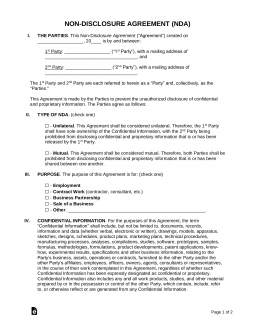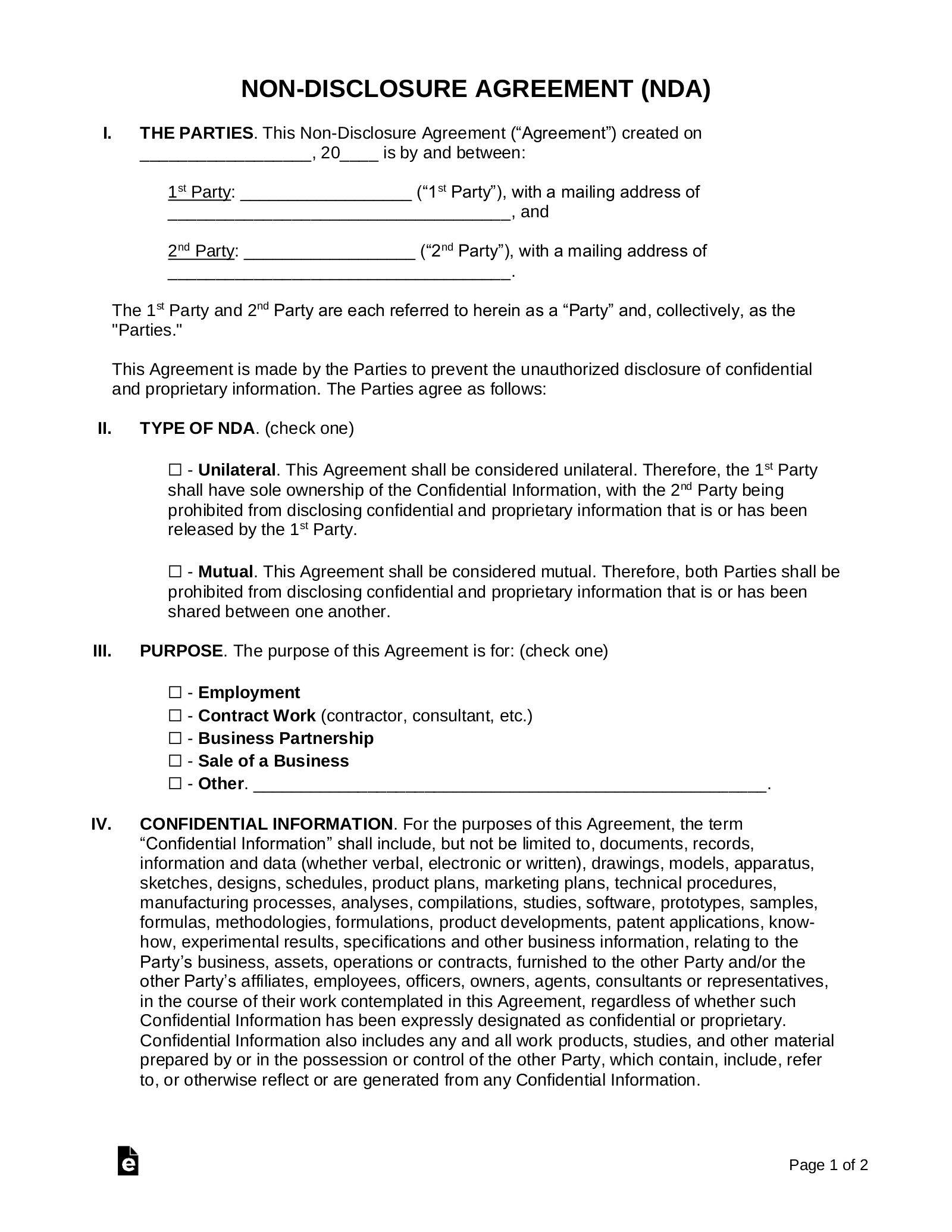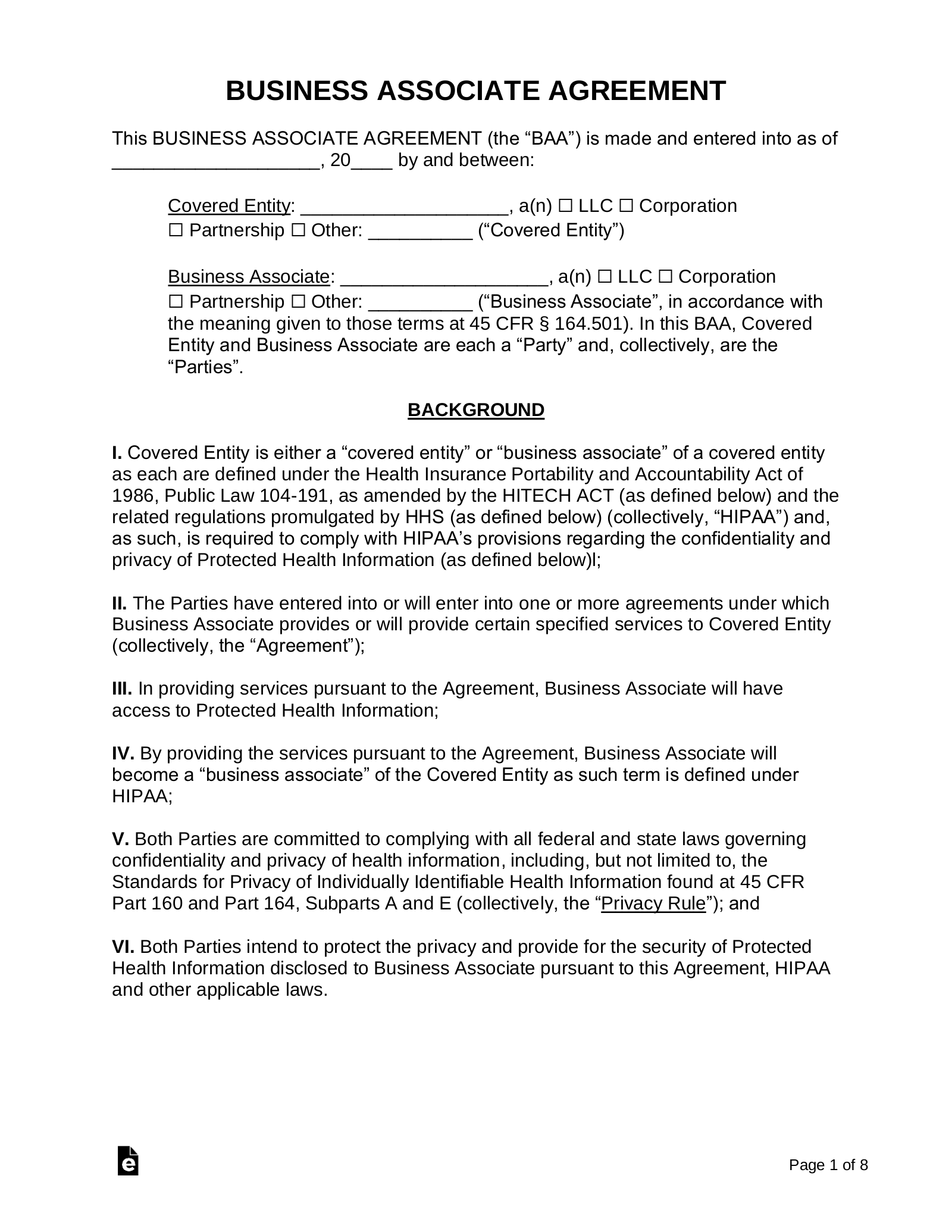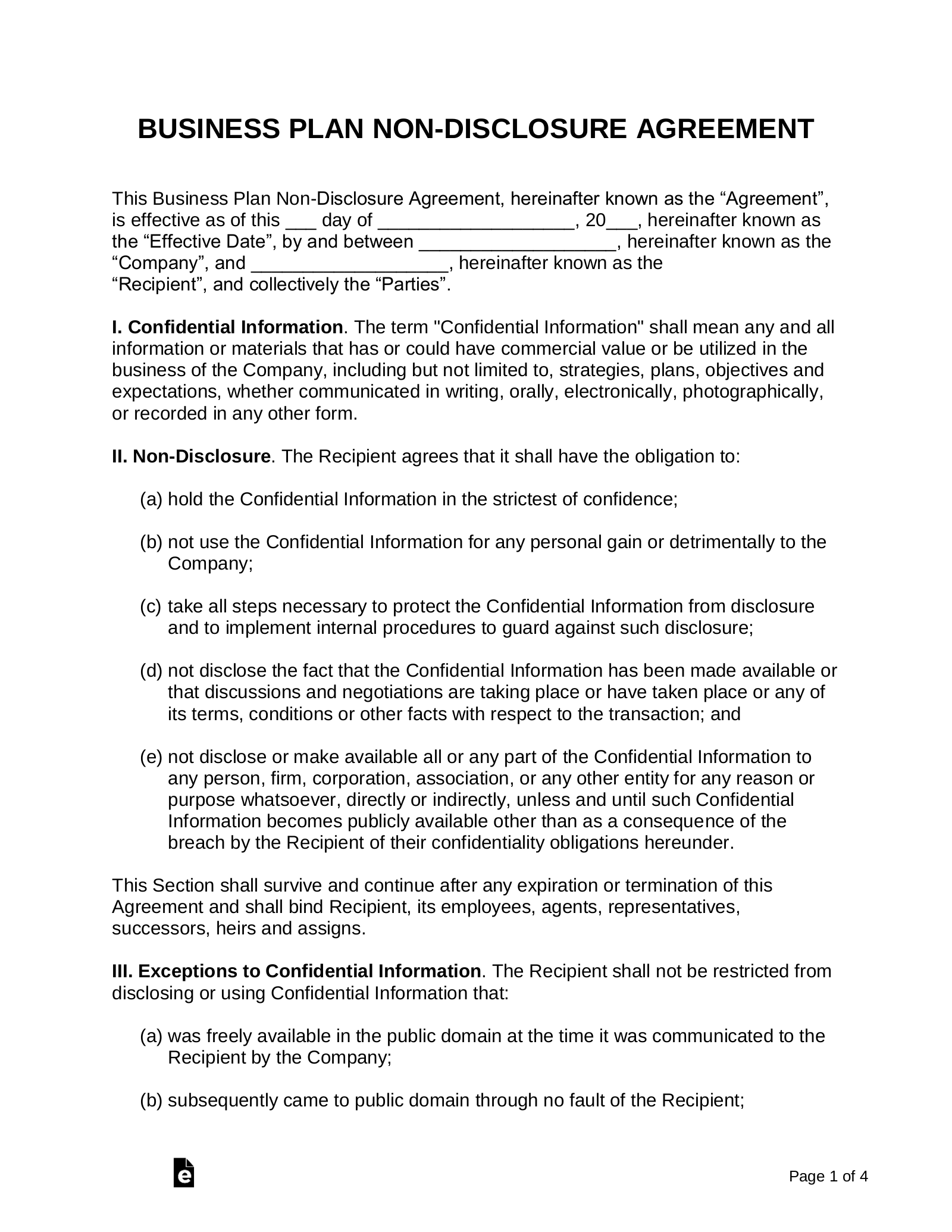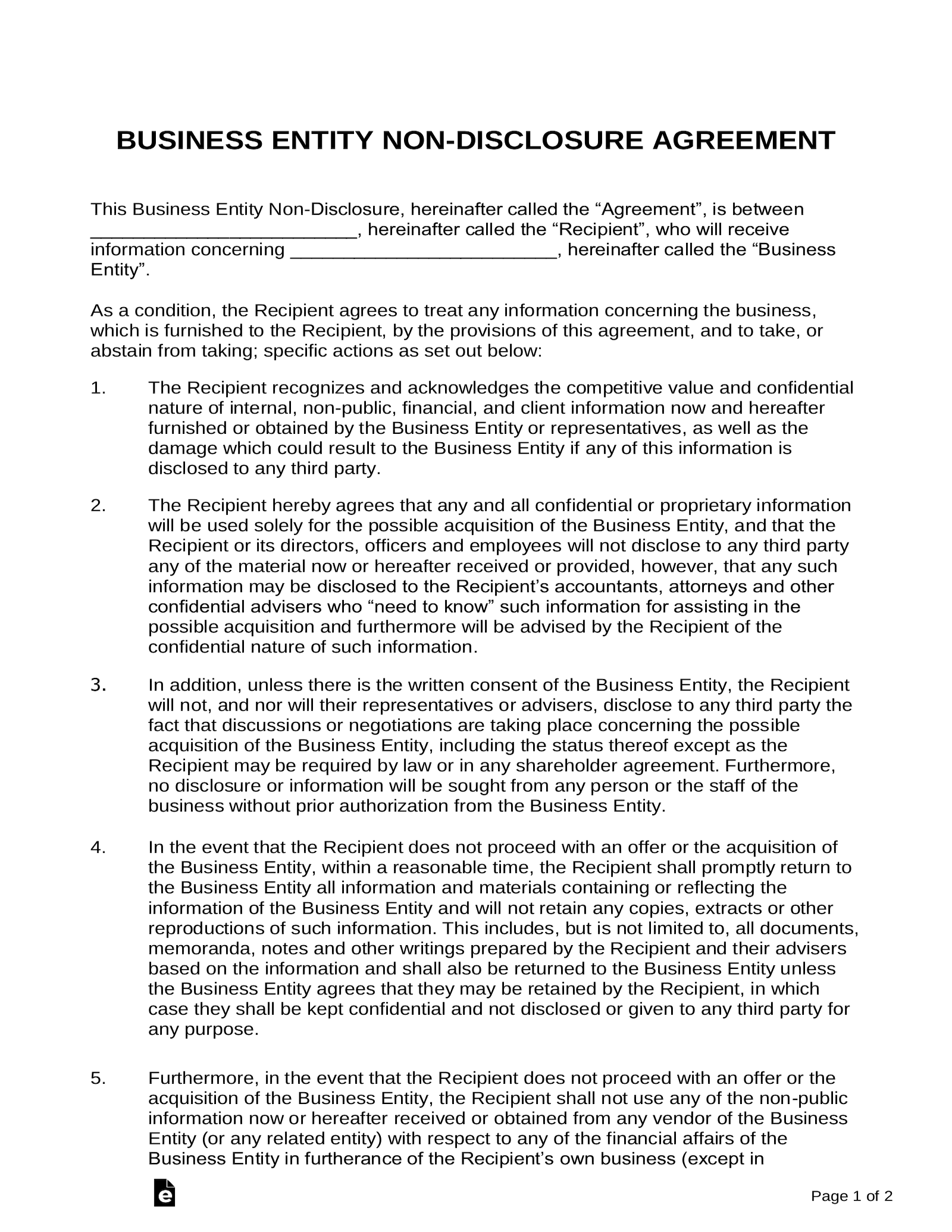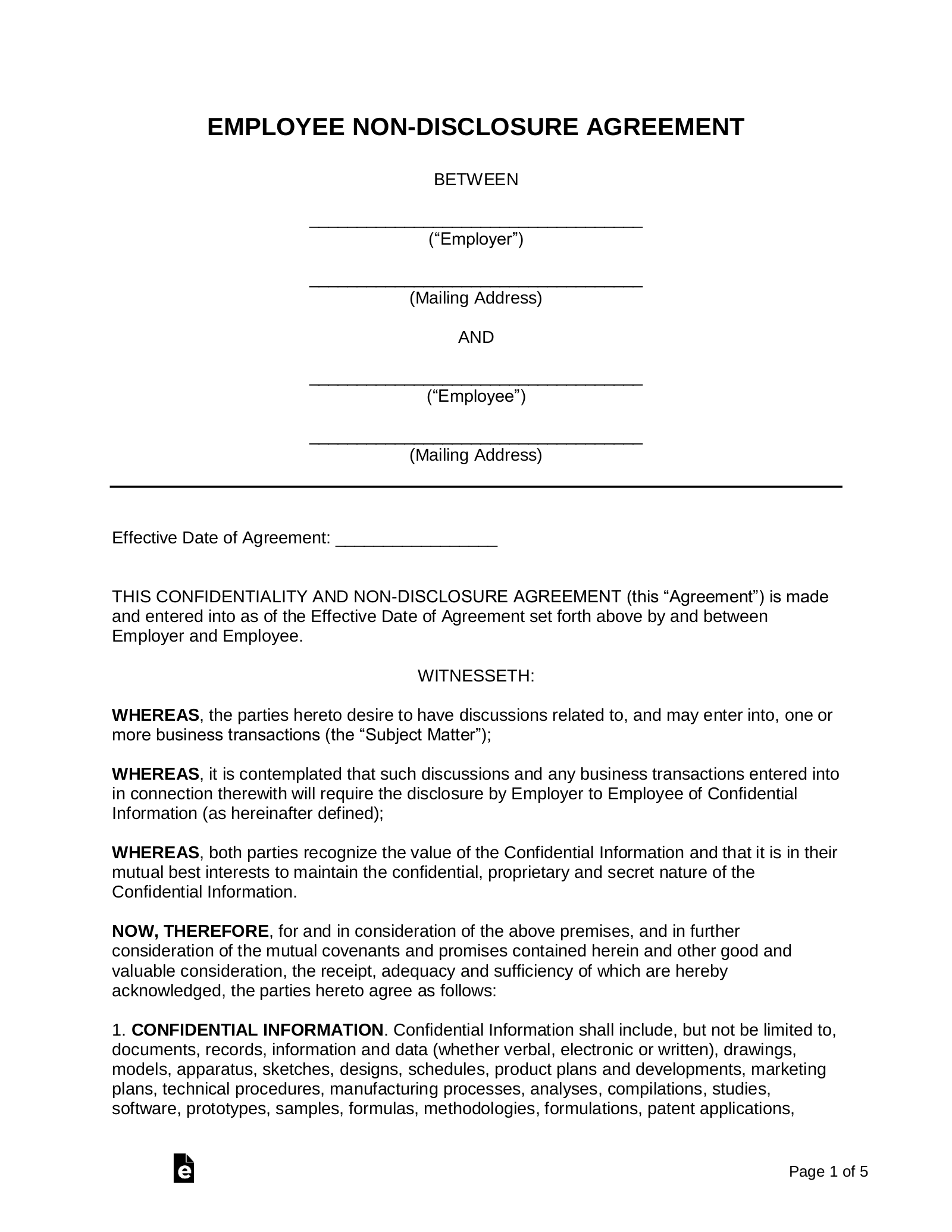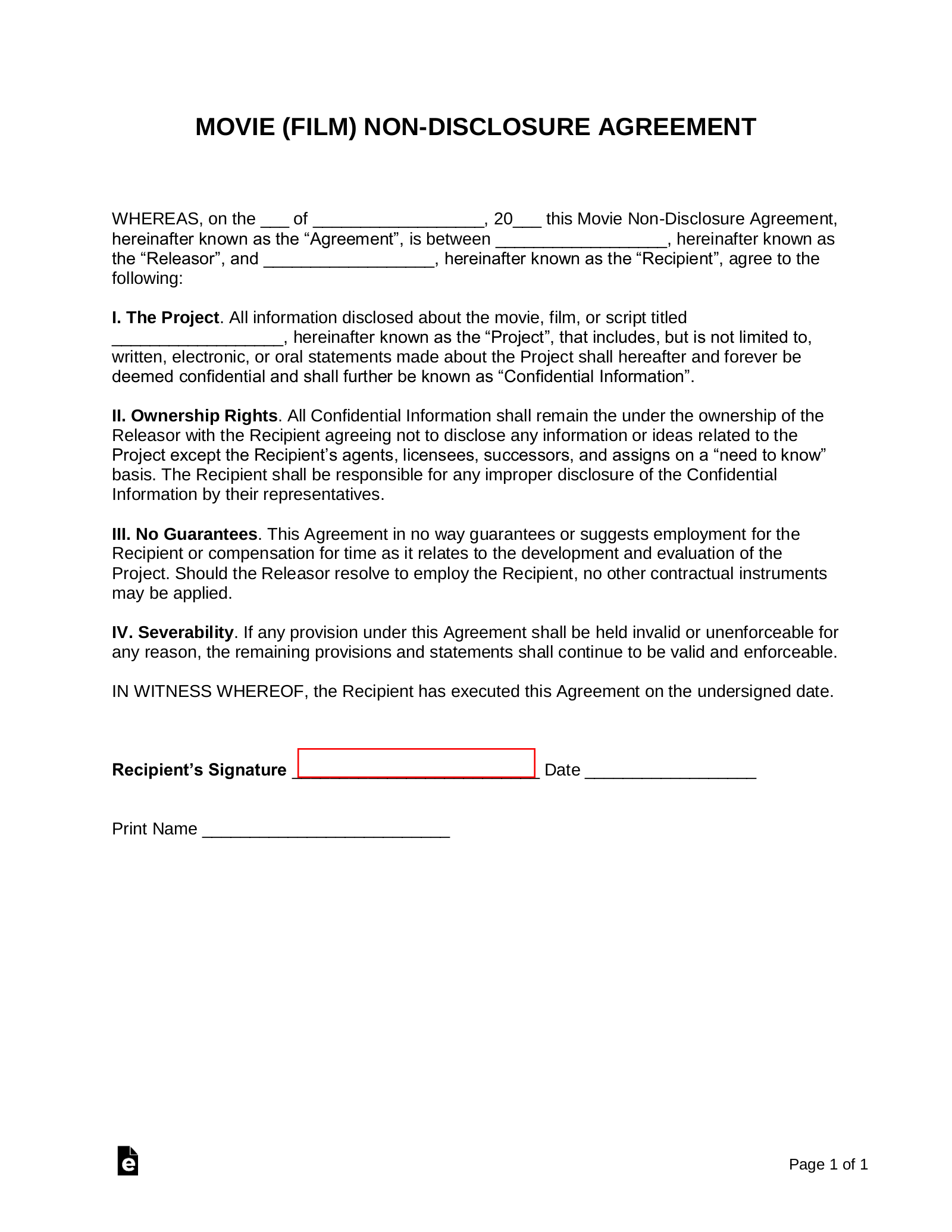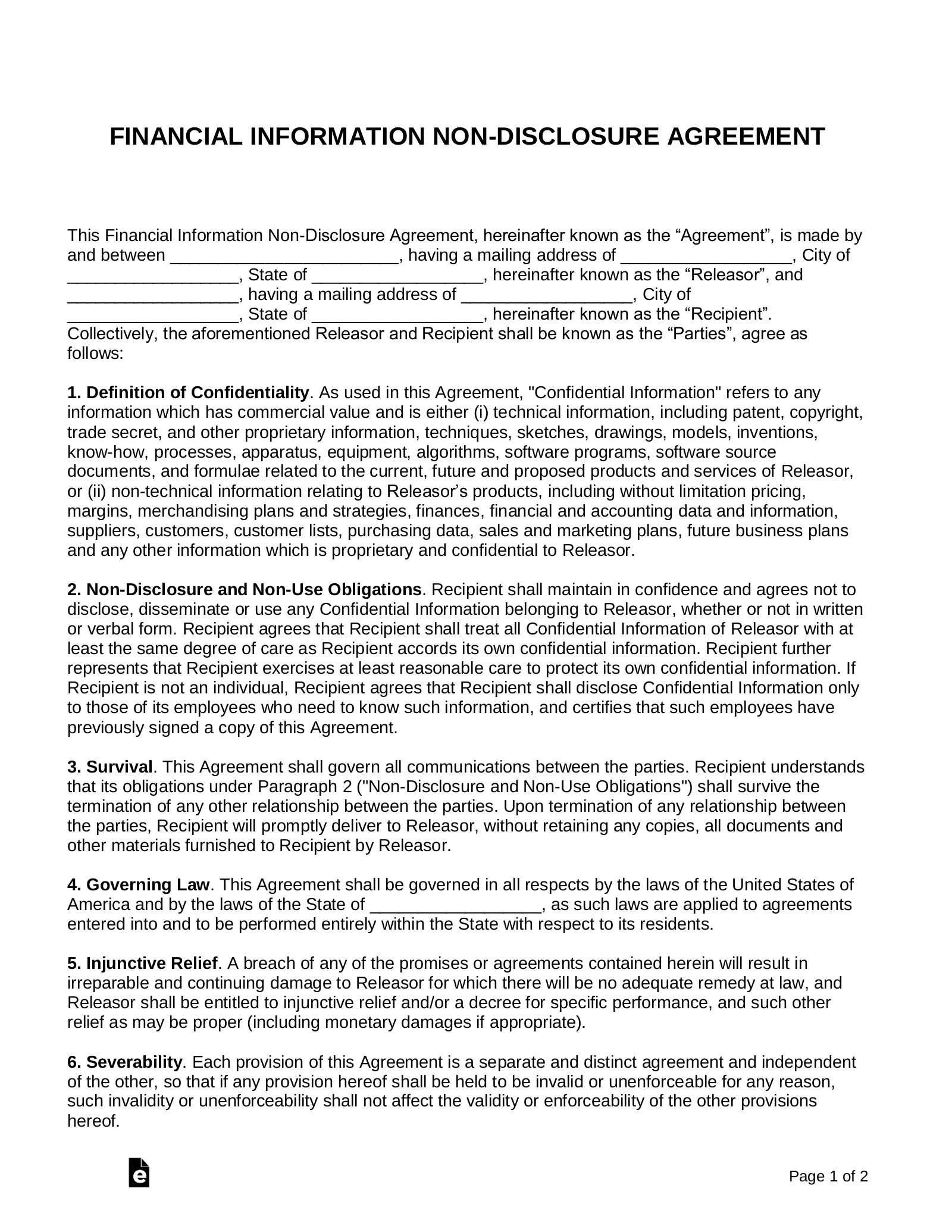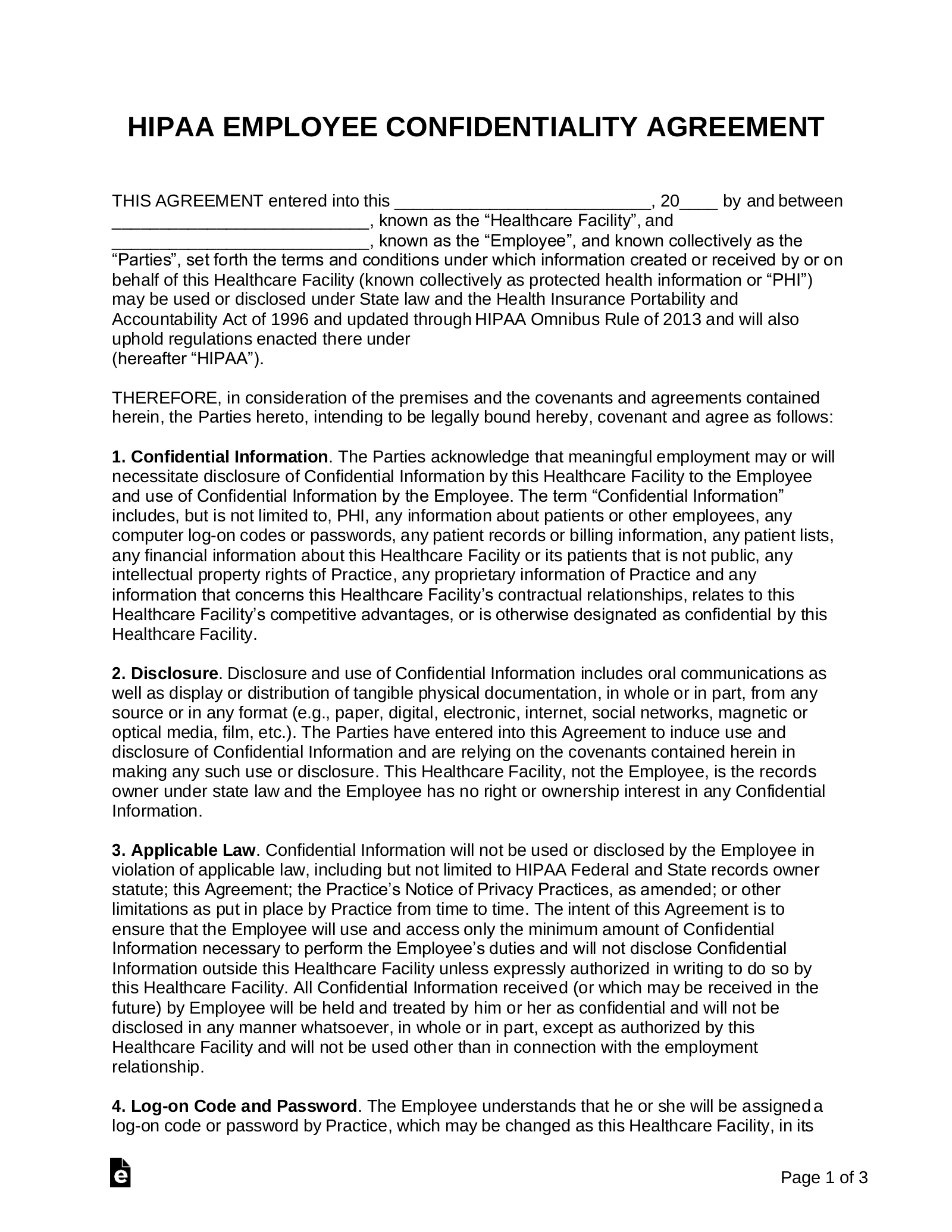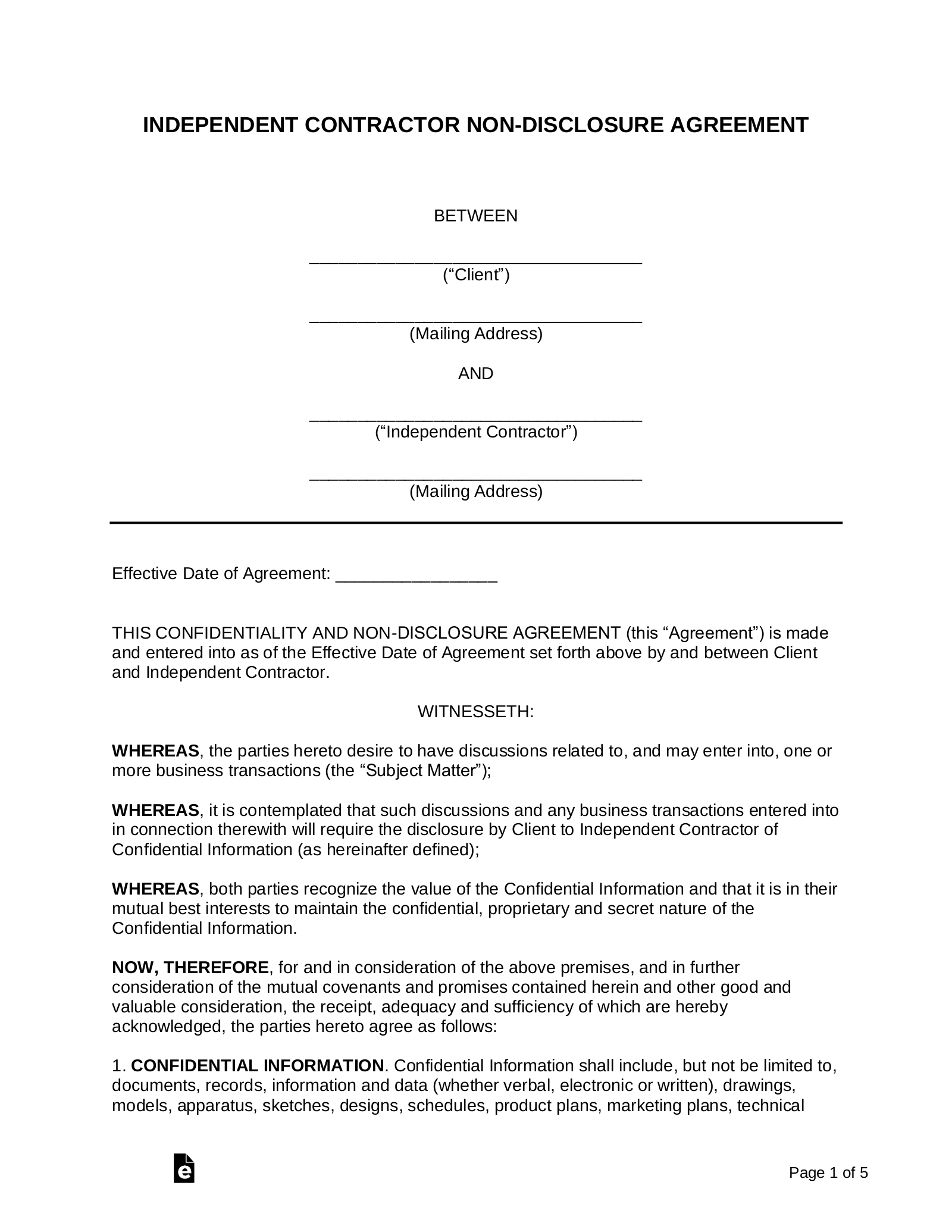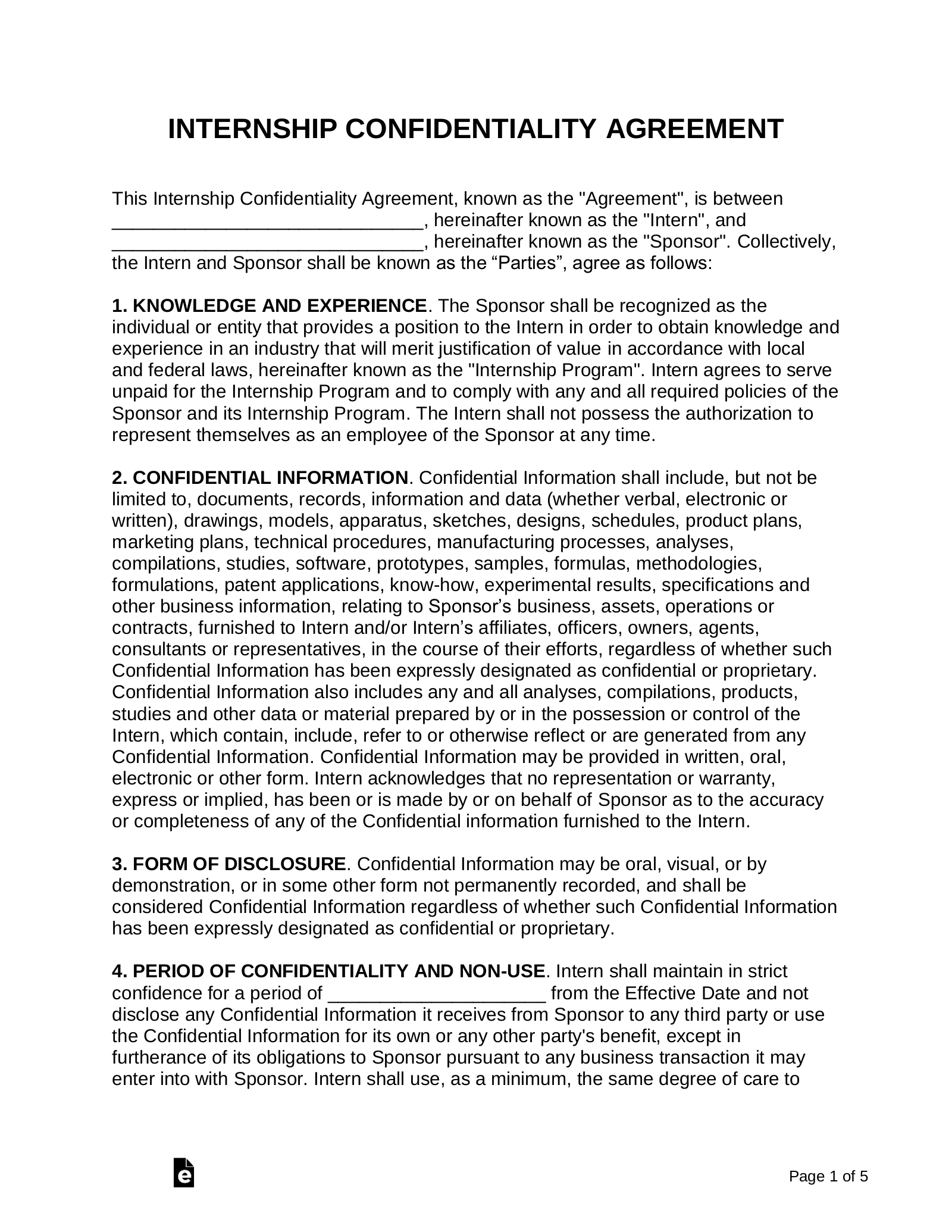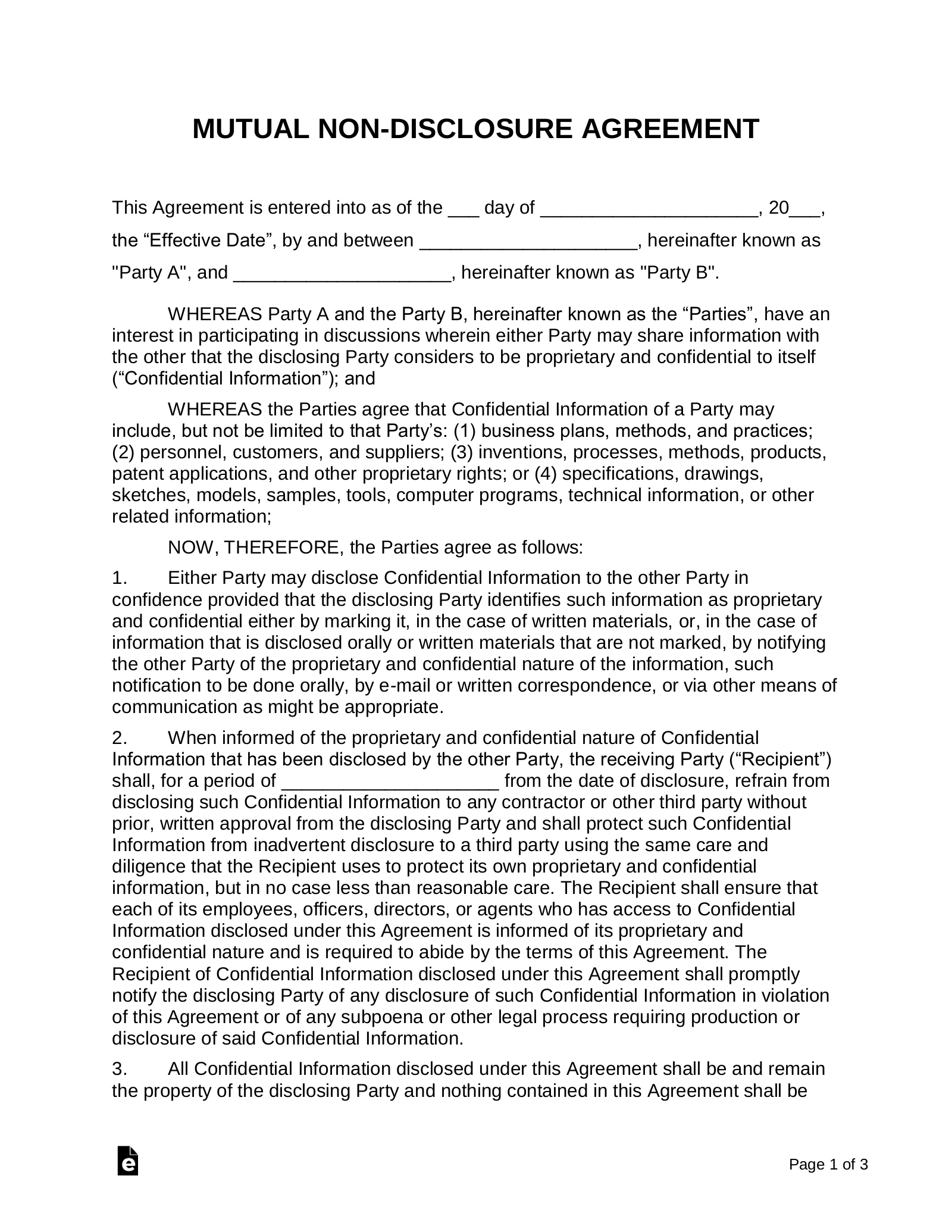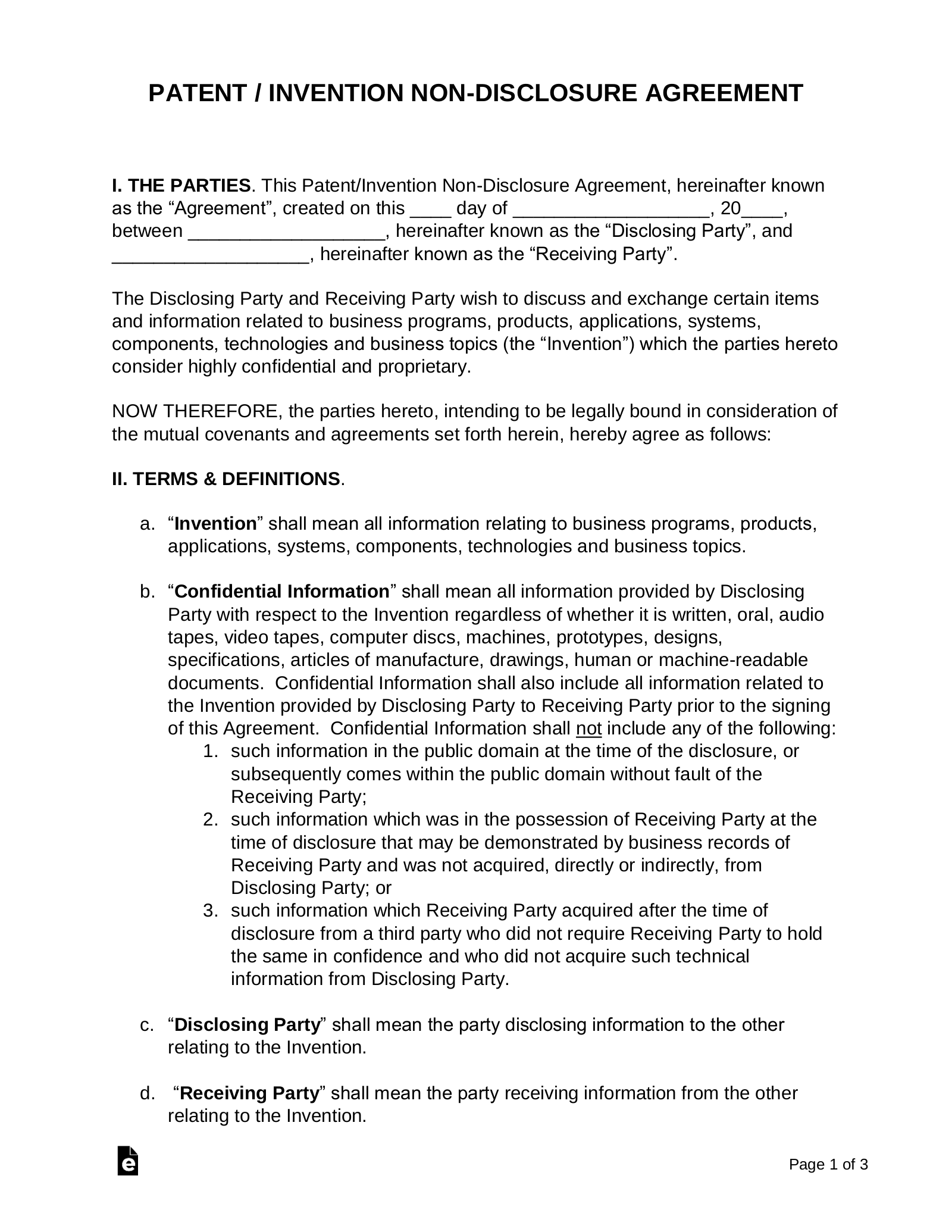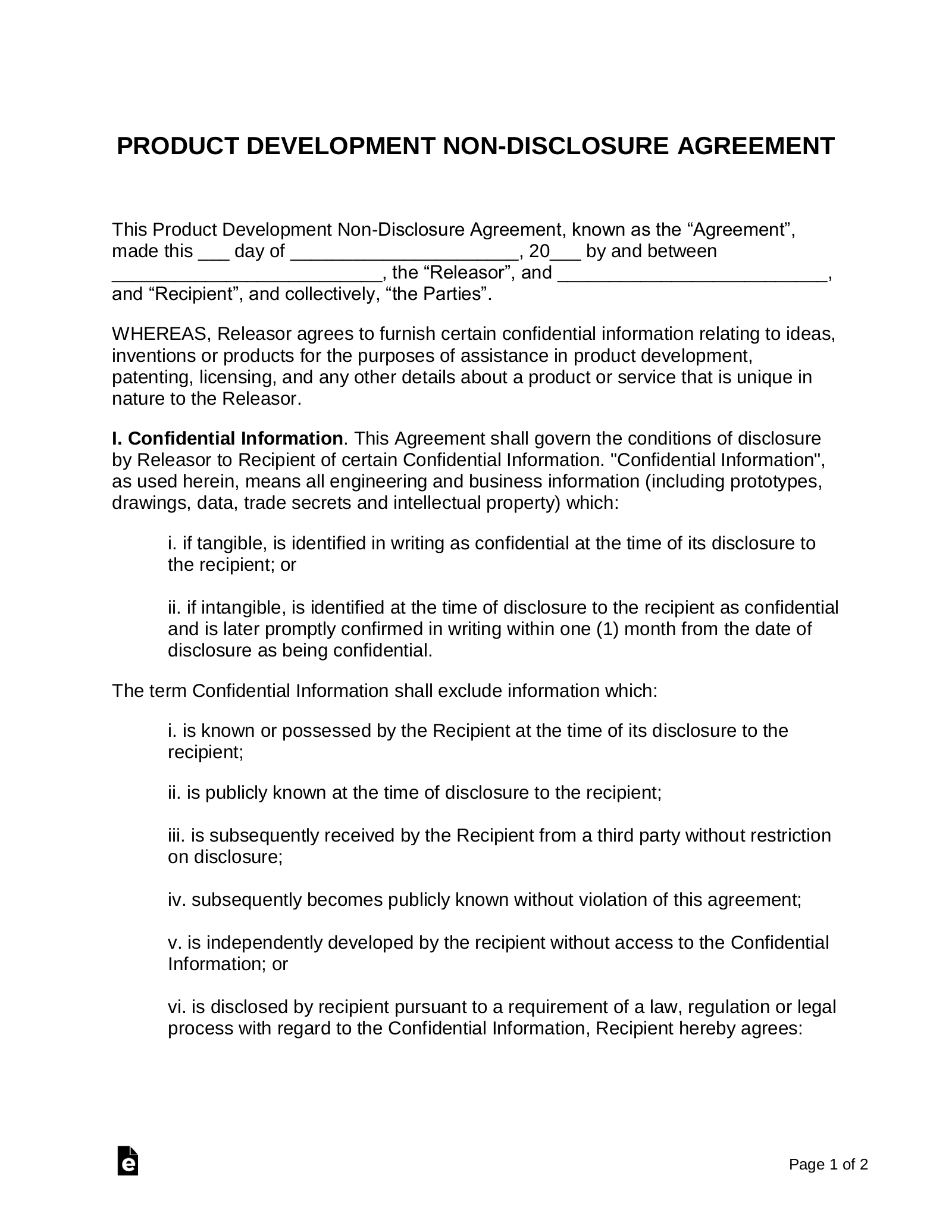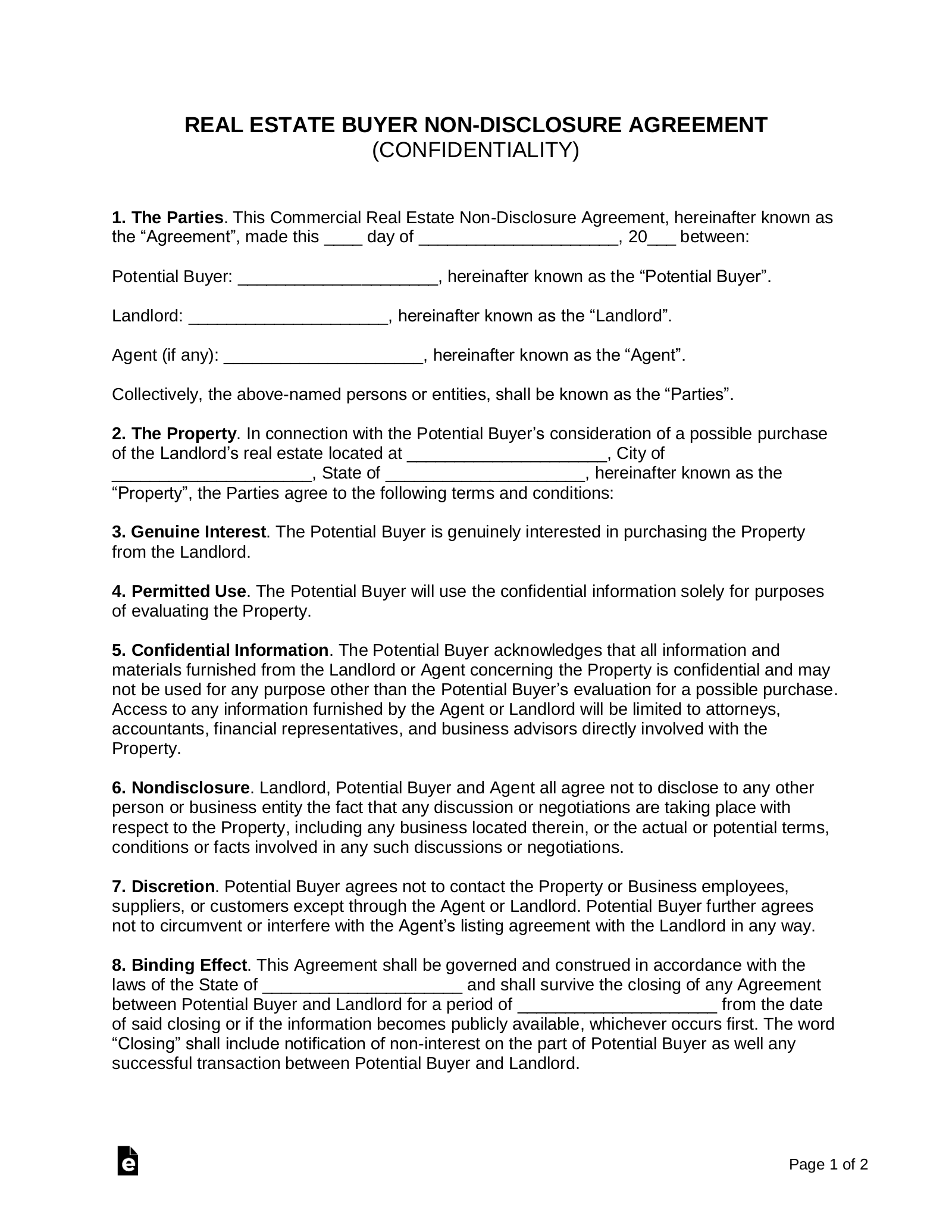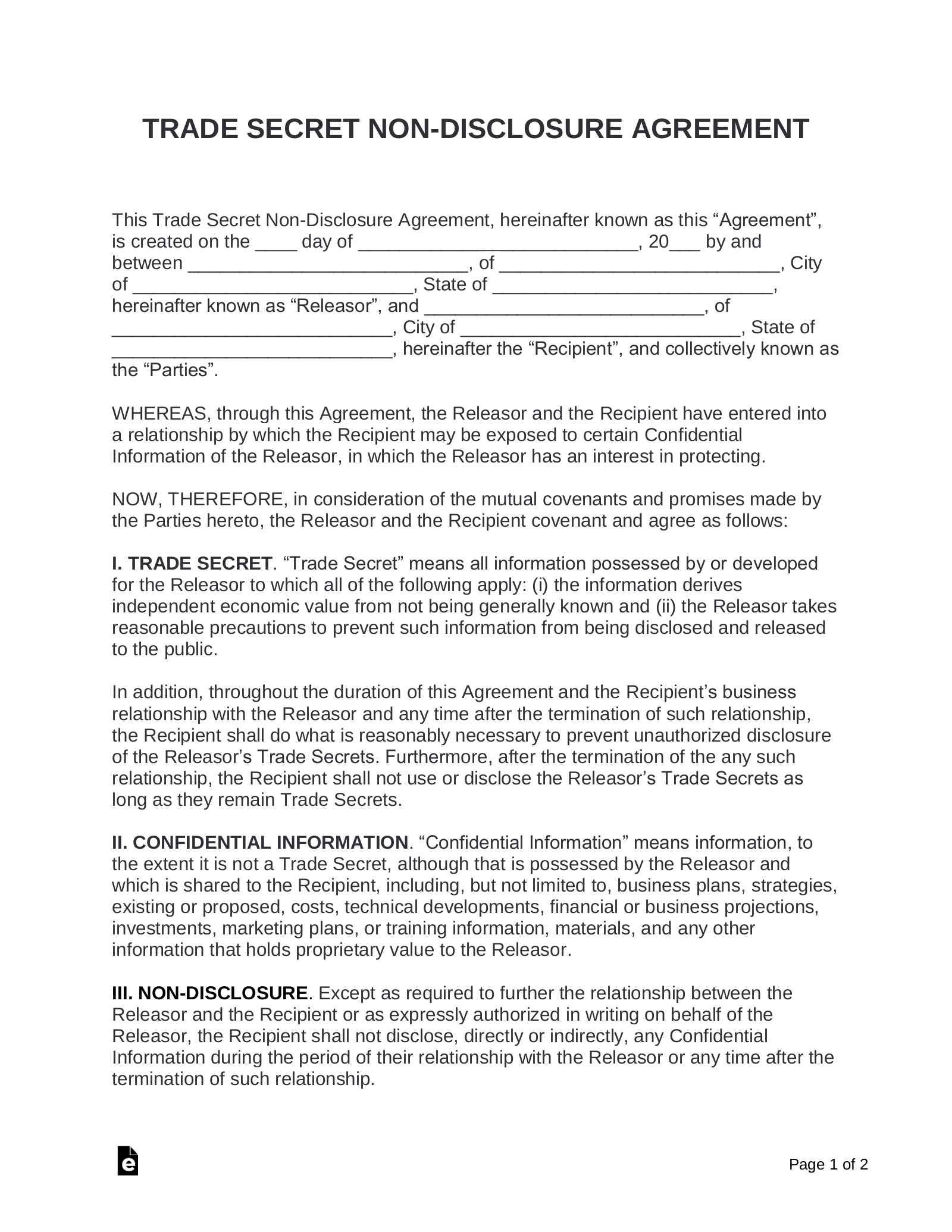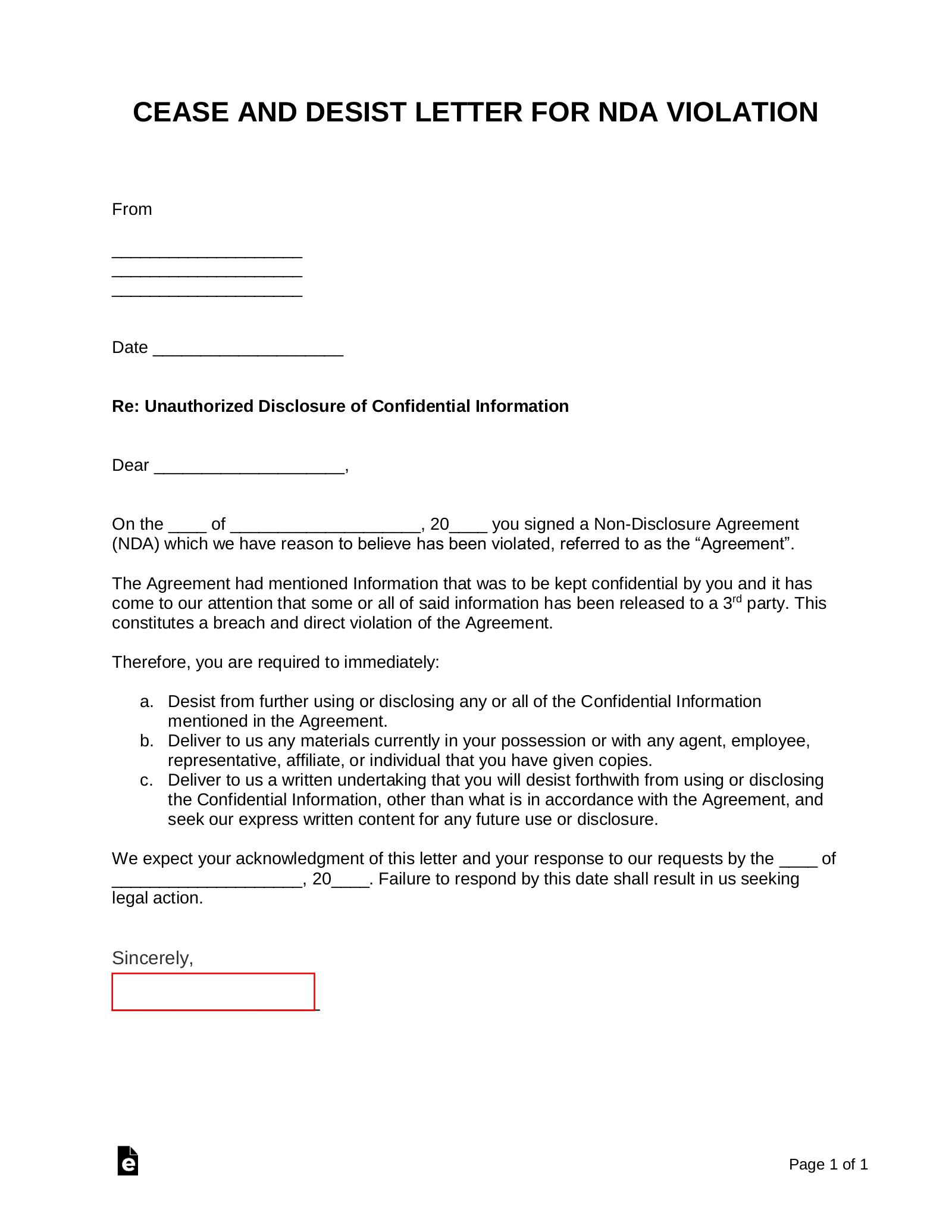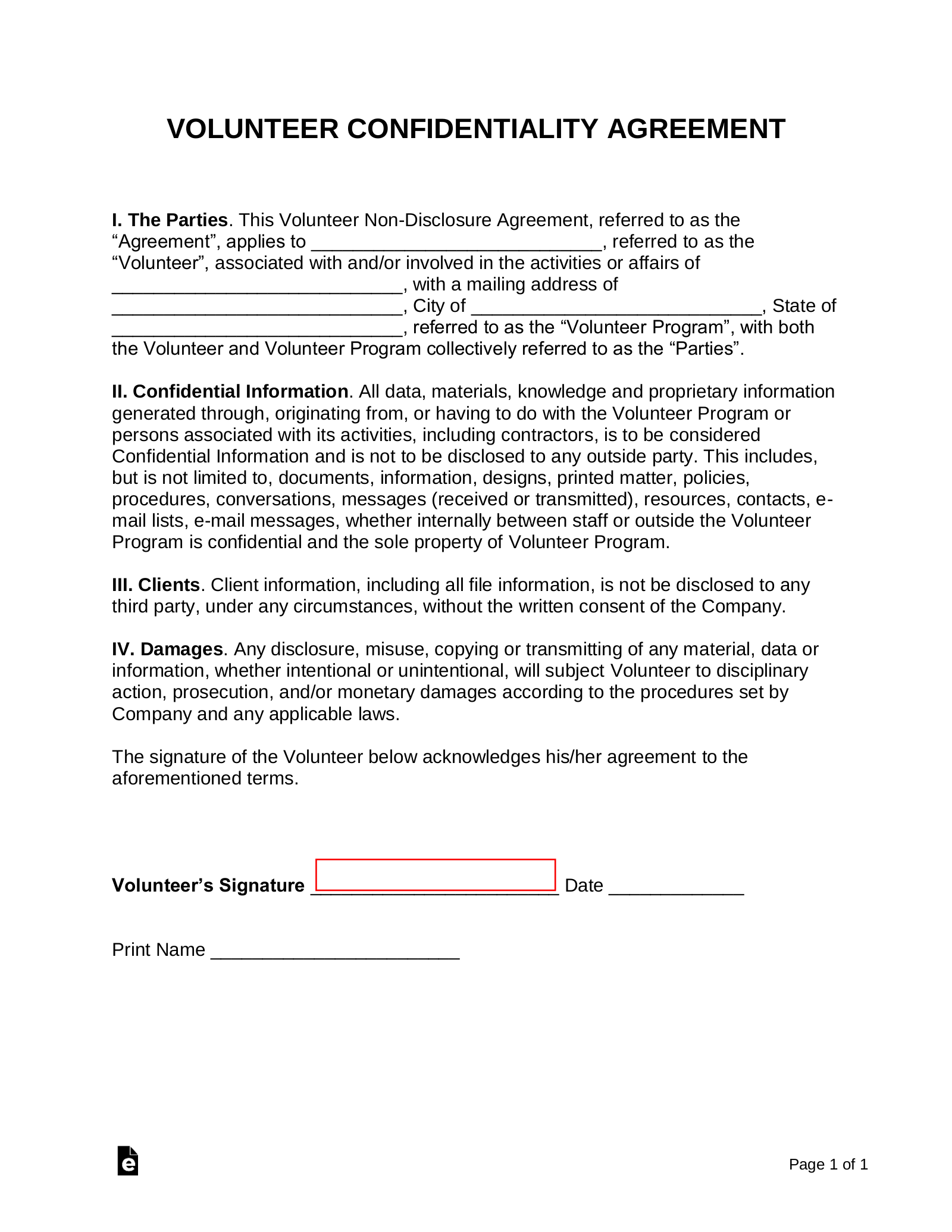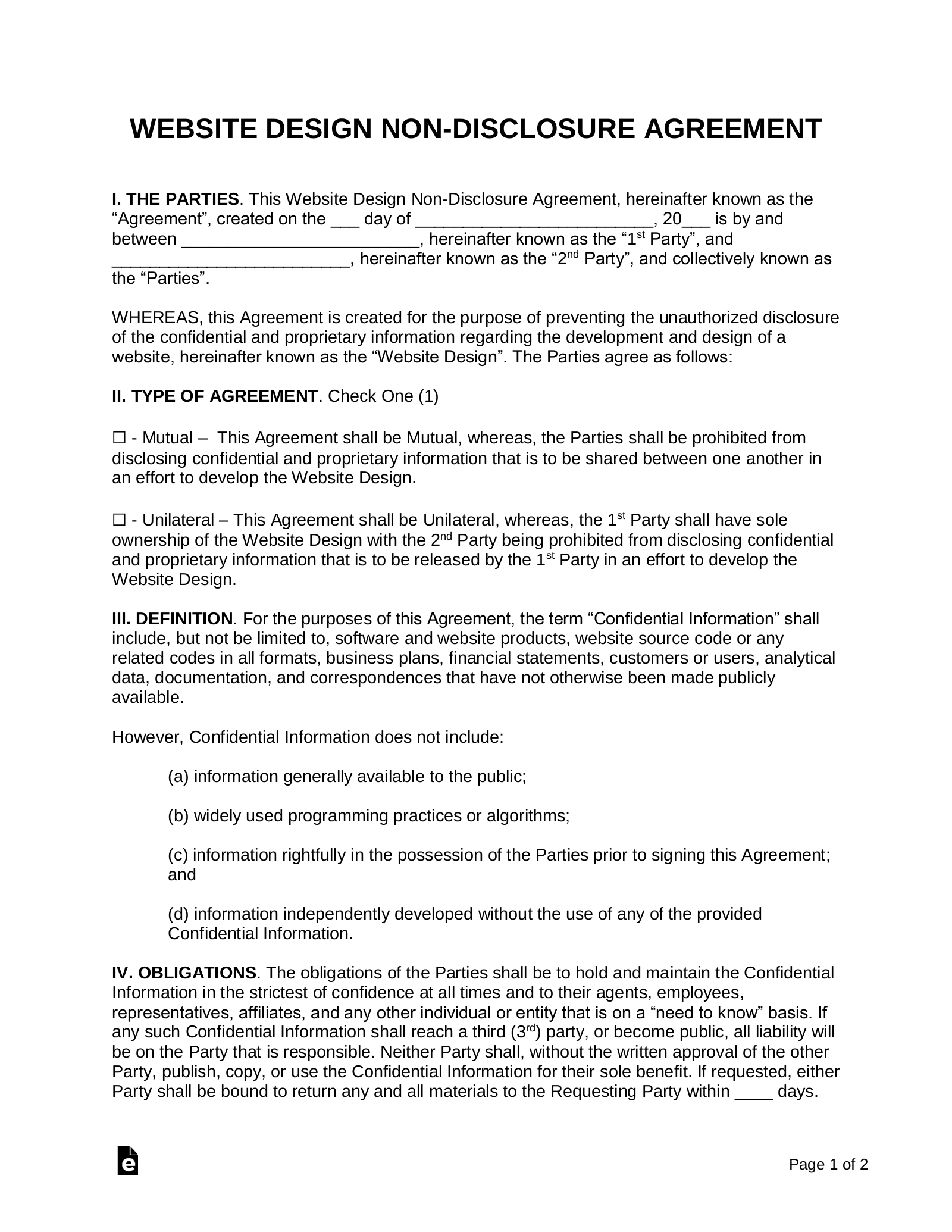Updated March 11, 2024
A non-disclosure agreement (NDA) restricts an individual or party from releasing or publicly sharing the confidential information of another party. It is intended to protect trade secrets or valuable information that the releasor does not want to be revealed publicly.
What if an NDA is violated?
If any terms of an NDA are breached, the violating party could face the following:
- Attorney’s fees – Legal fees of the opposing party.
- Breach of contract – Penalties for violating a binding contract.
- Financial liability – If monetary damages are proved.
- Injunction – A court order prohibiting someone from further NDA violation.
- Legal action – Requiring the hiring of legal counsel to defend oneself.
By State
- Alabama
- Alaska
- Arizona
- Arkansas
- California
- Colorado
- Connecticut
- Delaware
- Florida
- Georgia
- Hawaii
- Idaho
- Illinois
- Indiana
- Iowa
- Kansas
- Kentucky
- Louisiana
- Maine
- Maryland
- Massachusetts
- Michigan
- Minnesota
- Mississippi
- Missouri
- Montana
- Nebraska
- Nevada
- New Hampshire
- New Jersey
- New Mexico
- New York
- North Carolina
- North Dakota
- Ohio
- Oklahoma
- Oregon
- Pennsylvania
- Rhode Island
- South Carolina
- South Dakota
- Tennessee
- Texas
- Utah
- Vermont
- Virginia
- Washington
- Washington D.C.
- West Virginia
- Wisconsin
- Wyoming
By Type (21)
Table of Contents |
What is a Non-Disclosure Agreement (NDA)?
A non-disclosure agreement — commonly known as an NDA or a confidentiality agreement — is a legally binding contract establishing a confidential relationship between two or more parties.
By contractually prohibiting the recipient party from releasing any sensitive knowledge, such as trade secrets or financial information, an NDA allows the involved parties to work together openly without fear of sensitive information becoming public knowledge.
Common Uses
1. Employees & Contractors
Employees are often required to sign an NDA as a condition of employment, particularly in the tech industry or entertainment. It restricts employees from sharing valuable company details they may learn on the job.
Similarly, contractors are often required to sign an NDA about the project they are working on with a company.
2. Joint Ventures Between Businesses
When two or more companies are considering a joint venture, they typically sign an NDA when commencing business. Before entering into a formal agreement, doing due diligence on the other party is often necessary.
Signing a confidentiality agreement allows them to mutually share sensitive company knowledge without fear of it becoming public knowledge.
3. Potential Investors
Similarly, confidentiality agreements are commonly used when a business, particularly a start-up, when raising capital. Potential investors are likely to require the company to reveal proprietary information if the success of the business depends on it.
Requiring them to sign an NDA prior to sharing valuable information helps to keep it from reaching unauthorized parties.
Unilateral vs Mutual
Unilateral NDA
One party releases information to another party, most commonly in employer-employee arrangements in which the employee will have full access to all company and business information in order to do their job.
Mutual NDA
Two or more parties mutually release and share sensitive information with one another in an effort to create an end product or service. All signing parties are legally bound to the NDA. This is a common prerequisite to forming a joint venture or business relationship.
How long does an NDA last?
It does not have an end date unless specified. However, if a person signs an NDA as a condition of employment, it’s best to check the laws of the state where the disclosing party is located. This is because each state can have its own statutes on the maximum duration allowed for restrictive covenants.
Do Non-Disclosure Agreements Expire?
No, an NDA generally does not expire unless specified in the agreement. However, because trade secrets and proprietary information typically lose value over time, they may define the circumstances in which the terms of confidentiality no longer apply.
What happens if you BREAK an NDA?
While violating a confidentiality agreement is not considered a crime in itself, it still carries consequences under contract law. If someone breaches the terms, they would likely face a lawsuit and be subject to the penalties outlined in the NDA.
Common Penalties
- Monetary fines. The violating party is subject to monetary and legal damages.
- Termination of employment. Employees who reveal trade secrets from their employer can be terminated and held liable for damages.
NDAs Involving Trade Secrets
If a breach of confidentiality involves stealing or leaking a trade secret, this can be charged as a criminal offense under 18 U.S. Code § 1832.
Under this law, mishandling a trade secret can lead to:
- Up to 10 years in prison
- Fines of up to $5 million or three times the value of the stolen trade secret
Definitions & Provisions of an NDA
- Confidential Information
- Effective Date
- Misappropriation
- Obligations
- The Parties
- Recipient
- Releasor
- Relationship
- Trade Secret
Confidential information – Also known as “proprietary information.” This can include verbal, electronic, or written material, financial information, product plans, sketches, methodologies, and more.
Effective date – The day the agreement becomes active. Depending on the terms, an NDA can remain active until the confidential information no longer qualifies as a trade secret, or until the bound party is released from the contract via a written notice.
Misappropriation – Wrongful use of confidential information by the recipient party. This includes publishing, copying, or using the information for their own benefit or sharing it with a third party.
Obligations – Each party’s role is described in the NDA. Typically, this includes holding and maintaining confidential information in the strictest of confidence. Information is shared with employees on a “need-to-know” basis.
Parties – The individuals or entities bound by the NDA. In a non-mutual NDA, one party is the releasor, while the other is the recipient. In a mutual NDA, all parties are BOTH the releasor and the recipient.
Recipient – The individual or entity that is receiving confidential information. Examples include employees, contractors, suppliers, business collaborators, and more.
Releasor – The individual or entity that is releasing confidential information. Also known as the “disclosing party,” the releasor discloses confidential information to the recipient after the NDA has been signed.
Relationship – The nature of the arrangement between the two parties and the reason for sharing confidential information. Examples include employer-employee, contractor-client, supplier-company, and more.
Trade secret – Intellectual property and other sensitive information that is not publicly known. It typically provides a company with a competitive or economic advantage. This can range from formulas and R&D to financial information.
Sample Non-Disclosure Agreement
Download: PDF, MS Word, OpenDocument
NON-DISCLOSURE AGREEMENT (NDA)
1. THE PARTIES. This Non-Disclosure Agreement (“Agreement”) created on [DATE], is by and between:
1st Party: [NAME] (“1st Party”), with a mailing address of [ADDRESS], and
2nd Party: [NAME] (“2nd Party”), with a mailing address of [ADDRESS].
The 1st Party and 2nd Party are each referred to herein as a “Party” and, collectively, as the “Parties.”
The Parties make this Agreement to prevent the unauthorized disclosure of confidential and proprietary information. The Parties agree as follows:
2. TYPE OF NDA. (check one)
☐ – Unilateral. This Agreement shall be considered unilateral. Therefore, the 1st Party shall have sole ownership of the Confidential Information, with the 2nd Party being prohibited from disclosing confidential and proprietary information that is or has been released by the 1st Party.
☐ – Mutual. This Agreement shall be considered mutual. Therefore, both Parties shall be prohibited from disclosing confidential and proprietary information that is or has been shared between one another.
3. PURPOSE. The purpose of this Agreement is for: (check one)
☐ – Employment
☐ – Contract Work (contractor, consultant, etc.)
☐ – Business Relationship/Partnership
☐ – Sale of a Business
☐ – Other. [DESCRIBE]
4. CONFIDENTIAL INFORMATION. For the purposes of this Agreement, the term “Confidential Information” shall include, but not be limited to, documents, records, information and data (whether verbal, electronic, or written), drawings, models, apparatus, sketches, designs, schedules, product plans, marketing plans, and more.
However, Confidential Information does not include:
(a) information generally available to the public;
(b) widely used programming practices or algorithms;
(c) information rightfully in possession of the Parties prior to signing this Agreement; and
(d) information independently developed without the use of any of the provided Confidential Information.
5. OBLIGATIONS. The obligations of the Parties shall be to always hold and maintain the Confidential Information in the strictest of confidence and to their agents, employees, representatives, affiliates, and any other individual or entity that is on a “need to know” basis. If any such Confidential Information shall reach a third (3rd) party, or become public, all liability will be on the Party that is responsible.
This Section shall not apply to the 1st Party if this Agreement is Unilateral, as marked in Section II.
6. TIME PERIOD. The bounded Party’s(ies’) duty to hold the Confidential Information in confidence shall remain in effect until such information no longer qualifies as a trade secret or written notice is given releasing such Party from this Agreement.
7. INTEGRATION. This Agreement expresses the complete understanding of the Parties with respect to the subject matter and supersedes all prior proposals, agreements, representations, and understandings. This Agreement may not be amended except in writing with the acknowledgment of the Parties.
8. SEVERABILITY. If a court finds that any provision of this Agreement is invalid or unenforceable, the remainder of this Agreement shall be interpreted so as to affect the intent of the Parties best.
9. ENFORCEMENT. The Parties acknowledge and agree that due to the unique and sensitive nature of the Confidential Information, any breach of this Agreement would cause irreparable harm for which damages and/or equitable relief may be sought. The harmed Party in this Agreement shall be entitled to all remedies available at law.
10. GOVERNING LAW. This Agreement shall be governed under the laws in the state of [STATE].
IN WITNESS WHEREOF, the parties hereto have executed this Agreement as of the date written below.
1st Party’s Signature ______________________________ Date _________________
Print Name ______________________________
2nd Party’s Signature ______________________________ Date _________________
Print Name ______________________________
NDA vs. Non-Compete Agreement
The main difference is that an NDA prohibits an individual from releasing information to a competitor. At the same time, a non-compete agreement does not allow an individual to be employed by a competitor.
NDA
- Does not allow the employee to disclose proprietary information
- Not restricted in any state
- Not restricted to the industry of employment
Non-Compete Agreement
- Does not allow the employee to work for a competitor
- Restricted in many states (including Arizona, California, Florida, Hawaii, Massachusetts, Texas, Utah, Virginia, and Washington)
- Restricted to the industry of employment
How to Write an NDA (6 steps)
- Choose Your NDA Template
- Select a Type of NDA: Unilateral or Mutual
- Define “Confidential Information”
- Enter the Consequences of a Breach
- Sign the Non-Disclosure Agreement
- Disclose the Information
An NDA can be filled out with or without the help of an attorney. While legal counsel is always recommended, you may navigate the process on your own as long as you follow the directions closely.
1. Choose Your NDA Template
 Select a template from the NDA types or for your specific state. You can tailor the document to suit your particular arrangement, establishing the scope of confidential information prohibited from being disclosed as part of the agreement.
Select a template from the NDA types or for your specific state. You can tailor the document to suit your particular arrangement, establishing the scope of confidential information prohibited from being disclosed as part of the agreement.
2. Select a Type of NDA: Unilateral or Mutual
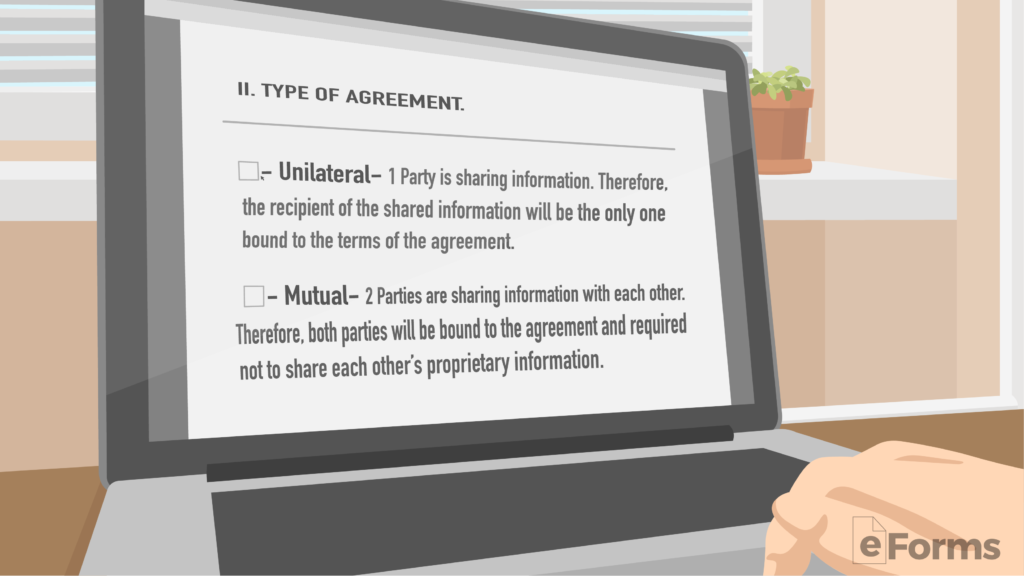 After selecting your form, you will need to decide whether the form is unilateral (one-way) or mutual (two-way). This is determined by how many of the parties are sharing information.
After selecting your form, you will need to decide whether the form is unilateral (one-way) or mutual (two-way). This is determined by how many of the parties are sharing information.
- Unilateral – One party is sharing information. Therefore, the recipient of the shared information will be the only one bound to the terms.
- Mutual – Two or more parties are sharing information with each other. Therefore, all parties will be bound to the terms and are prohibited from sharing each other’s proprietary information.
3. Define “Confidential Information”
 This is the most important part of the agreement.
This is the most important part of the agreement.
It is best to define exactly what “confidential information” is. For example, it could be a movie script, software coding, patentable information, etc. In addition to naming this information, related details should be included, such as marketing strategies, target customer base and more.
4. Enter the Consequences of a Breach
 List the consequences the receiving party would contractually face if they violate the contract by sharing the information with a third party. This typically involves legal action, monetary compensation, and any additional damages that the disclosing party can claim due to the breach of contract.
List the consequences the receiving party would contractually face if they violate the contract by sharing the information with a third party. This typically involves legal action, monetary compensation, and any additional damages that the disclosing party can claim due to the breach of contract.
The governing state is determined by the disclosing party’s jurisdiction, not the agreement’s violator.
5. Sign the Non-Disclosure Agreement
 It is best to have the parties sign the NDA with a notary acknowledgment, as this will verify the identity of each individual. If the parties elect not to have a third party witness the signing, it is recommended that each signature closely matches the individual’s driver’s license to ensure its validity.
It is best to have the parties sign the NDA with a notary acknowledgment, as this will verify the identity of each individual. If the parties elect not to have a third party witness the signing, it is recommended that each signature closely matches the individual’s driver’s license to ensure its validity.
6. Disclose the Information
 After the execution of the confidentiality agreement, the respective parties may release confidential information to one another. The receiving party should always retain the information in confidence and only share it with agents, representatives, employees, affiliates, and any other individuals on a “need-to-know” basis. All liability will be on them if any confidential details are made public.
After the execution of the confidentiality agreement, the respective parties may release confidential information to one another. The receiving party should always retain the information in confidence and only share it with agents, representatives, employees, affiliates, and any other individuals on a “need-to-know” basis. All liability will be on them if any confidential details are made public.

